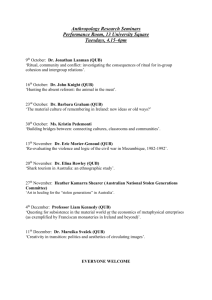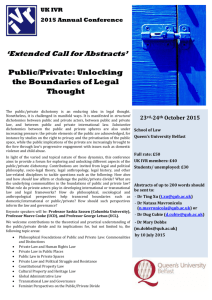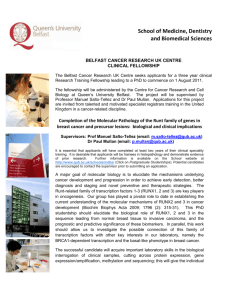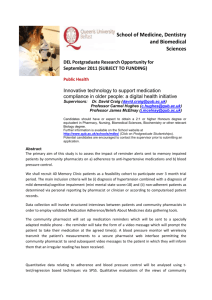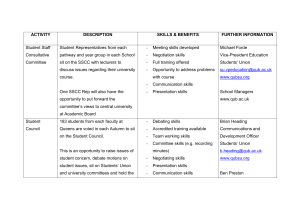Safety Talk for Postgraduate Students and Researchers
advertisement
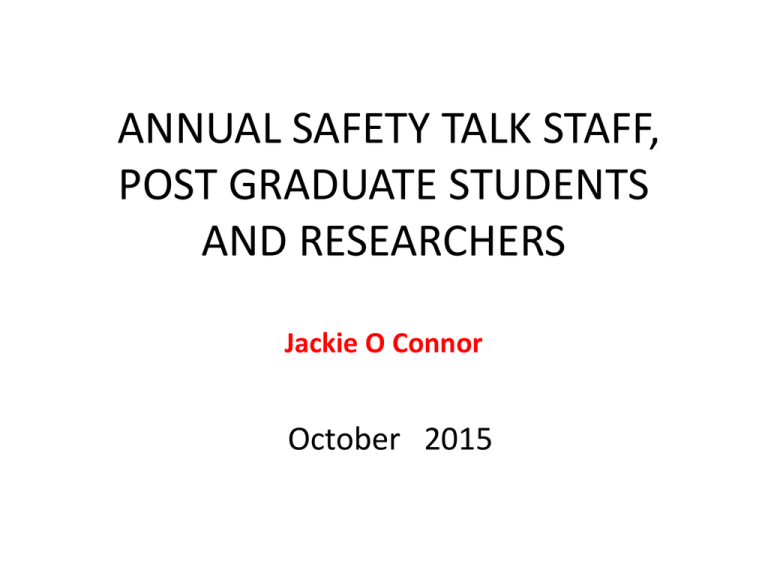
ANNUAL SAFETY TALK STAFF, POST GRADUATE STUDENTS AND RESEARCHERS Jackie O Connor October 2015 IMM Prof Steven Bell, Director of Research Ken Pringle (Secretary) • • • • • • • • • • • • • Bell, S.E.J. Prof de Silva, A.P. Prof. Doherty, A.P. Dr. Holbrey J. Dr. Lane, I. Dr. Nockemann P. Dr Mangwandi C.Dr Mills A. Prof Poulidi , D. Dr Themistou, E.Dr Vyle, J. Dr. Walsh, P Dr Xiao, B, Dr OB.124 LG.112 01.102 02.217 OG.123 01.411 LG437 01.401 LG438 LG440 LG.410 LG.431 LG439 4470 4422 4481 4836 5470/4458 4475 4378 4339 4065 4172 5485 5570 4463 s.bell@qub.ac.uk a.desilva@qub.ac.uk a.p.doherty@qub.ac.uk j.holbrey@qub.ac.uk i.lane@qub.ac.uk p.nockemann@qub.ac.uk c.mangwandi@qub.ac.uk andrew.mills@qub.ac.uk d.poulidi@qub.ac.uk e.themistou@qub.ac.uk j.vyle@qub.ac.uk p.walsh@qub.ac.uk b.xiao@qub.ac.uk CenTACat Prof David Rooney, Director of Research Heather McDonald (Secretary) Artoli, N, Dr Blesic M,Dr Abu- Darieh , J. Dr Atkins, M Prof Burch, R.Prof Goguet, A Dr Hardacre, C. Prof. Holbrey, J. Dr Hu, P. Professor Jacquemin, J. Dr James, S.L. Prof Lagunas, C. Dr. Manyar, H. Dr. Marr A.C. Dr. Muldoon, M. Dr Robertson, P.Prof Rooney, D.R. Prof. Seddon, K.R. Prof. Thompson, J. Dr Lin Wen Feng Dr LG432 LG432B 01.142 LG441 02.424 02.432 02.428 02.104 02.422 02.426 01.426 01.425 02.433 02.423 02.421 0G425 02.426 01.421 02.421 LG.442 4474 4691 4269 4295 4416 4882 4592 4863 4259 4389 5419 4436 4868 4442 4844 4627 4050 5420 4844 4175 N.Artoli@qub.ac.uk m.Blesic@qub.ac.uk j.abudahrieh@qub.ac.uk martin.atkins@qub.ac.uk r.burch@qub.ac.uk a.gouget@qub.ac.uk c.hardacre@qub.ac.uk j.holbrey@qub.ac.uk p.hu@qub.ac.uk johan.jacquemin@qub.ac.uk s.james@qub.ac.uk c.lagunas@qub.ac.uk h.manyar@qub.ac.uk a.marr@qub.ac.uk m.j.muldoon@qub.ac.uk p.robertson@qub.ac.uk d.rooney@qub.ac.uk k.seddon@qub.ac.uk jilllian.thompson@qub.ac.uk w.lin@qub.ac.uk University’s Statutory H and S Duties The University has a duty of care to each and everyone of us(staff, students, visitors, contractors etc.) to ensure our health, safety and welfare are maintained by: • Making sure the workplace is safe and without undue risk • Ensuring that the equipment that you use is safe and fit for purpose( PAT, COSHH, PSSR) • Provide adequate welfare facilities when needed • Provide adequate instruction, training and expert supervision University’s Statutory H and S Duties It must also, by Law: A) Prepare a General Statement of Health and Safety Policy B) Provide any Protective Clothing or Equipment as required by Health and Safety at Work legislation C) Report certain Injuries, Diseases and Dangerous Occurrences To The Enforcing Authority (HSE) School Health and Safety Policy ALL STAFF MANDATORY COURSES available on QOL DISPLAY SCREEN EQUIPMENT(DSE) USERS • MANDATORY DSE RISK ASSESSMENT CONDUCTED ON YOUR WORKSTATION for ALL STAFF • Forms from QOL or • Safety Officer(DSE RISK ASSESSOR FOR THE SCHOOL) • Self assessment Secondary DSE RA may be necessary- DSE assessor • Signed off by line manager and copy retained by DSE assessor • Provision of free eyesight tests and glasses if deemed necessary to DSE user on completion of DSE1 form( see safety officer) University Smoking Policy Smoking is prohibited within ALL University buildings, temporary buildings and University owned vehicles Exceptions-individual study bedrooms and some other designated areas Smoking shelters- Quad or side of Ashby ONLY- NOT OUTSIDE DOORWAYS INTO BUILDING Working Hours • Experimental work is only permitted 7am-7pm MONDAY -FRIDAY (Normal working hrs) • Laboratory work OUTSIDE of these days and times(weekends, late night, holidays etc )is ONLY allowed if an OUT OF HOURS PERMIT is obtained and signed by supervisor and Safety Officer and kept by user( to be shown to security if need be) OUT of hours working is ONLY allowed for LOW RISK WORK!!!! • LONE WORKING in laboratories is NOT PERMITTED at any time • LATE NIGHT WORKING UP TO 11pm ONLY • Sign in and out procedure –use book outside General Office on Stranmillis entrance when entering/leaving building out of hours or at weekends/evenings School of Chemistry and Chemical Engineering Out of Hours / Lone Working Policy The School’s core working hours are 7:00 to 19:00 Monday to Friday. Safety support services (eg fire wardens, first aiders) are not available outside these hours. Undergraduates (including final year project students) must not work alone in laboratories at any time. An experienced PHD student/ member of staff must always be present. Undergraduates are only permitted to do practical work within the period 9:00 to 18:00 on weekdays during term time unless hired under various work experience schemes, for which special provisions apply. (The School Safety Adviser should be consulted in such cases) Experimental work in laboratories is permitted within the period 7:00 to 19:00 Monday to Friday (i.e., core working hours). If there are exceptional reasons why it is necessary to conduct laboratory work outside of the normal working hours, the following arrangements apply. Late working (19.00-23.00), and daytime working at week-ends or holidays –permission is required from both the supervisor and the School Safety Officer, and the appropriate School Out of Hours Working Permit must be signed PRIOR to work commencing. Permission will only be granted for low risk work activities and will be conditional upon having two persons always present in the laboratory. Anyone working outside the normal hours must comply with the requirements to sign in/out and notify University Security, as set out below. Overnight working (23.00 – 7.00) – this is not normally permitted, on safety grounds. If there are exceptional reasons why such work is required, it must be discussed in advance with the School Safety Officer, whose written permission is required. This applies to all forms of overnight working, including office-based work. Research Students may not work alone on experiments which, in the opinion of their supervisors and after conducting a risk assessment, present special hazards. No specific permission is required for office-based work which is carried out between the hours of 7.00 and 23.00. Outside core working hours, staff must comply with the requirements to sign in/out and to notify Security on 5099. Anyone who is working on the premises outside core hours must comply with the following security procedures: Use the signing in /out book located outside the General Office on the ground floor – this may mean people leaving their offices at 19.00 to sign in; AND Inform Security via a telephone call to 5099 when commencing work (or at 19.00 hours if already at work) AND AGAIN when leaving the building Anyone entering or leaving the building before 7.00 and after 19.00 pm during the week, and at any time at weekends/holidays, must sign in/out in the book outside the General Office on the Stranmillis Road entrance. People should NOT be working in the building after 23.00 unless specific permission is sought Your H&S Duties as Student/ PDRA Researchers • You have a duty to familiarise yourself with the University’s and the School’s health and Safety Policies( safety manual and H&S notice board on ground floor outside LG111) • You must take reasonable care of your own health and safety and that of others when conducting experiments • You must cooperate with and obey the University and it’s officers in all matters pertaining to Health and Safety • You must follow a supervisor’s recommendations and expert advice when it comes to matters of health and safety and do not disregard what they say. Your Supervisor’s Duties • Your supervisor is responsible for ensuring you work within established health and safety guidelines and you are NOT put at jeopardy or risk when doing experiments authorised by them. • Your supervisor should advise you of ALL risks associated with your work and give you clear instruction and advise how to conduct the work in a SAFE fashion without risk to yourself and others • Your supervisor should ensure that you are provided with Any Personal Protective Equipment(PPE) that is deemed necessary for the work you are conducting upon conducting a risk assessment Sources of Information Web sites: • www.hse.gov.uk/coshh/index.htm • wwww.hse.gov.uk/chemicalclassification/classification/what-is-chemicalclassification.htm • www.qub.ac.uk/directorates/HumanResource s/OccupationalHealthandSafety/ Points of Contact in School • • • • • Prof Hardacre - Head of School Prof Karl Hale - Chair Safety Committee Jackie O Connor - Safety Officer Prof Steven Bell - Laser Safety Adviser Simon Murray (QUESTOR)-School Biological Safety Adviser • Kirin Hill - Electrical Safety issues • Dr Neil Ogle- Radiation Protection Supervisor(SPACE) School of Chemistry & Chemical Engineering Health and Safety Committee Membership and phone extension • Prof. Karl Hale • Mrs Jackie O’Connor • • • • • • • • • • (Chairman, School Health & Safety Committee) (Safety Officer, School of Chem. & Chem. Eng., 4673) Ms. Fiona Mulligan (Secretary, Trade Union Rep) Mr. George Burton (Trade Union UNITE, 4433) Prof. S.E. J. Bell (Laser Safety Adviser 4470, 4460) Mr. Caomhan Stewart Research Student Representative(Centacat) 4462 Mr. Aaron O Kane Research Student Representative (Synbioc) 4076 Ms. Katherine McBride Research Student Representative (IMM) 4073 Mr. T. Sewell Laboratory Manager, ASEP, 5579, 5580 Dr. Maggel Deetlefs QUILL Asst Director, 4863 Dr. Julie Anne Hanna Questor Manager ATU 4675 Rep from ALMAC ALMAC 02890225588 EMERGENCY PROCEDURES • Emergency Telephone Number: • 2222 ( Emergency Services) from ANY phone in building or phone in corridor beside toxic gas break glass • 5099(Security Control 24 hrs ) Emergency Procedures Finding a Fire • Raise the alarm • 2222 ( Emergency Services) • Fire extinguishers – use ONLY IF COMPETENT TO DO SO • Switch off equipment that may pose a hazard ONLY if it is quick and easy to do so- DO NOT ENDANGER YOURSELF BY DELAYING EVACUATION • Evacuate the premises ( 2 assembly areas) Manual call point Designated Assembly Areas • Stranmillis Road evacuation- Ashby building foyer • Rest of building- car park opposite Sonic Arts building Emergency Procedures FIRE • • • • • • • Fire Alarm Sounding Klaxon sounds continuously Switch off equipment- if quick and easy to do so Leave laboratory by nearest Emergency Exit Obey Fire Wardens- report if there is dangerous equipment still running Do not congregate at emergency exits Go to designated assembly areas Do not enter building while red beacons are illuminated at entrance doors TOXIC GAS ALARM Emergency Procedures TOXIC GAS • • • • • • • Toxic Gas Alarm- blue manual break glass Klaxon sounds intermittently Evacuate immediately avoiding: Lab 01.430( telephone call point here) Lab 01.201(telephone call point here) Lab 02.435(telephone call point here) and basement stairwell leading to Liquid Nitrogen storage area Telephone call point inside main doors lobby ground floor January 2015 TRAINED BREATHING APPARATUS USERS Four sets of breathing apparatus have been installed in the School. All are located on the Lower Ground Floor opposite the Mass Spec Room LG.007. THIS EQUIPMENT IS STRICTLY FOR THE USE OF TRAINED PERSONNEL ONLY. These are: NAME CONOR MCGRANN CLIVE MURRAY DAVID COULTER PATRICK LYNER ROOM NUMBER LG 007/OG.414 LG.420 (Stores) 0G.202 LG.201 EXTENSION 4676/4435 4440 4067 4221 If there is a leak of compressed gas or a CO monitor is activated or the likelihood of oxygen deficiency as detected by Oxygen monitors in ANY room/lab you MUST leave that area immediately and contact any one of the above team AND the School Safety Officer Jackie O’Connor on 4673 ACCIDENT REPORTING Accident, dangerous occurrences & near misses occurring in /around the building are all reportable : • AC1 accident form MUST be completed by your supervisor/responsible person in charge • B1510 (accident book) must also be completed by the person who sustained the injury • Accident book is obtainable from Safety Officer- records kept confidentially. First Aid Arrangements Feb 2015 FIRST AIDERS IN THE SCHOOL OF CHEMISTRY & CHEMICAL ENGINEERING Patrick Lyner (Jan16) Kenneth Pringle (Mar16) Maggel Deetlefs (Jan 18) Jackie O Connor (Feb18) Angela Orozco (Feb 18) Julie Anne Hanna (Jun 17) Phillip McCarron (Jul16) LG.201 Tel 4221 Gen. Office OG.005 Tel 4253 Quill 02.102(a) Tel 4863 LG.014 Tel 4673 OB.437 Tel 5613 Questor 02.007 Tel 4675 Quill 02.403 Tel 5509 Individual Workers: Any pertinent health issues that could jeopardise your own health and safety and that of others must be discussed ASAP with your Supervisor and the School Safety Officer (Jackie O’Connor) e.g. epilepsy, diabetes, auditory and visual-impairment etc Pregnant Workers: It is your legal duty to inform the School as soon as you become aware that you are pregnant. The School will then conduct a Risk Assessment for you, and appropriate measures will be taken to ensure the Safety of you and your unborn child. You will not be penalised for this!!!!!! THESE RULES APPLY TO ALL CATEGORIES OF STAFF AND STUDENTS Before you begin ANY Experiment A Risk Assessment must be carried out: on an official School COSHH risk assessment form WHO BY? you in conjunction with your supervisor particularly if you are not sure of the hazards and risks involved in a particular process or unsure how to dispose of chemicals from your reaction in a safe manner WHY? 1. 2. 3. 4. It is a legal requirement It identifies the HAZARD/S of a particular experiment Estimates the RISKS associated with the hazard/s Indicates the precautionary measures(CONTROLS) that need to be implement to ensure everyone’s safety Before you begin ANY Experiment • COSHH RA Forms are available online or from Safety Officer (June 2015 version) • Once completed it MUST be signed FIRST by your supervisor/line manager then Sent to the Safety Officer to be signed • • One copy (signed by worker, supervisor AND Safety Officer) to be retained and readily available for inspection (RISK ASSESSMENT FOLDER) by the staff member/student • One copy given to the Safety Officer(electronic copies need to be signed first) ALL LABORATORY WORK SOULD HAVE A RISK ASSESSMENT HAZARD & RISK HAZARD – is the potential to cause harm. RISK – likelihood of that harm being realised. RISK RATING Risk = Severity x Likelihood Severity Likelihood Risk Rating Unlikely Possible Likely Very Likely Score Risk Level Very Minor 1 2 3 4 1-2 Low Minor 2 4 6 8 3-6 Medium Significant 3 6 9 12 8-9 High Major 4 8 12 16 12-16 Very High Action No further action necessary Although tolerable – monitor activity Further measures required Immediate action required – cease activity Hazard Factor Identified Risk of cuts from glassware Severity (1-4) Likelihood (1-4) Risk Level (L,M,H,VH) 2 2 4 MED 4 1 e.g. risk of electrocution 4 MED Control Procedure Visual inspection, discard ALL broken/chipped glass items Use threaded connections etc Visual inspection Current in date PAT test label Avoid contact between solutions and electrical connections Use in accordance with instructions slips, trips 3 2 6 HIGH working at height 3 3 9 HIGH Legionella 3 1 3 MED Manual Handling- lifting, moving equipment etc. 3 2 6 HIGH e.g. exposure to UV radiation 2 1 2 LOW Tidy all cables at back of apparatus. Use cable ramps on floors and walk ways. Clean up all spills immediately. Check floor covering regularly and defects reported Training. Inspection of ladders BEFORE use. Three points of contact. Suitable ladder for work. Clean and disinfect on a regular basis all vessels and pipework Assess the task, make it easier/lighter. Use of mechanical aid ,seek assistance from others etc. Suitable PPE( footwear) Use of full face mask and hand protection. Shielding where possible 3 MED Inspection of apparatus- leak tests of lines etc Pressure relief valve etc, Enclosure inside fume cupboard/ blast shield if appropriate Pressurised system- risk of explosion/ejection of gas/liquid etc 3 1 COSHH RISK ASSESSMENT • Title- your name and exp title • Location of work- lab number • Brief description- what you are doing and quantities of chemicals being used* • List substances and hazards- use MSDS(Material Safety Data Sheets) to get information • Nature of exposure- inhalation, ingestion, absorption etc • NB- pay particular attention to compounds that have WEL (workplace exposure limits assigned)- NEVER EXCEED THE VALUES STATED HOW TO PREVENT EXPOSURE • Eliminate the hazard- different chemical/ less risky method- pellets instead of powder, ready made solutions etc. • Prevent access to it( use guards- glove box/ fume cupboard etc. ) • Organise work so that exposure to yourself and others is minimised • Use APPROPRIATE PPE( on completion of risk assessment TYPES OF CONTROL/PRECAUTIONARY MEASURES • • • • • • • Total containment( glove box) Partial containment( Fume Cupboard) LEV local exhaust ventilation (fan and trunking) Dilution ventilation( open doors and windows) Work under inert atmospheres PPE Others- good working practices- restricting access to lab etc USING A FUME CUPBOARD Check speed-0.5m/sec with sash opened to 500mm DO NOT USE IF SPEED IS BELOW THIS VALUE- REPORT Fan On/Fan OFF Fan Speed MIN RUN MAX TYPES OF PPE • PPE is considered as a last resort in ADDITION to the former controls includes safety glasses , lab coat( mandatory) • Ensure gloves as suitable for the chemicals being used( see safety manual) • Additional PPE will be provided if deemed necessary e.g visors, aprons, goggles, hard hats, ear defenders safety footwear etc, Who else is likely to be exposed • Apart from yourself are risks adequately controlled? Are there local rules or SOPs ? • Other lab workers • Technical Staff • Cleaning staff • Maintenance staff( permit to work for internal fume cupboard repairs) • Contractors- as above AIR MONITORING AND HEALTH SURVEILLANCE • Air monitoring only needed if exposure cannot be adequately contained • Health Surveillance- where work involves the use of substances know to cause occupational asthma or severe dermatitis and where employees are exposed to carcinogenic/mutagenic cmpds. where exposure is NOT adequately controlled. or contact with chrome soln./ electrolytes containing chromic acid/ Cr salts / other substances that can cause skin cancer • PROCEDURES FOR SPILLAGES/ UNPLANNED RELEASES • Need to consider: Evacuation( lab/corridor/building) • How will alarm be raised( TOXIC GAS ALARM) • Will SCBA or Respirators be required( contact list of staff) • How will area be cleaned/ventilated • Special first aid requirements- using HF, PHENOL HOW TO DIPOSE OF HAZARDOUS WASTE • • • • • Small quantities low toxicity water miscible substances flushed to drain Small amts. vapours/gases/aerosols discharged into fume cupboard All other waste- solvents- in waste container in lab- disposed of in outside flammable storage facility All other waste generated- use the online Chemical Waste disposal form Biological waste- autoclaved and double bagged ( see Biological Safety officer) TRAINING Specialist training may be required- Lasers, various lab equipment,( centrifuges, autoclaves etc ) Training by academic staff/ post doc/technician to ensure: Competency to carry out process/expt safely Proper use of precautionary measures(inc PPE) Identify defects in precautionary measures(fume cupboard fail, PPE fail) Emergency procedures are adhered to Fatal Consequences-Why Risk Assessment is Vital • Jan 16th 2009- (Sheri) Sangji Sheharbano, 23yr old Chem Ph.D student of UCLA died from injuries sustained in a chemical fire in a lab on Dec 28th 2008 • Titrating t-Buli in a fume cupboard under N2 manifold • • Using plastic 60ml plastic syringe Plunger came out of barrel exposing t-Buli to atmosphere • Open bottle of hexane in FC also ignited • Sangji’s clothing caught fire and despite medical intervention she died of her third degree burns 18days later Lessons to be learned • NO RISK ASSESSMENT !!!!!!! • Inappropriate lab practice, lack of/no training • • • • • • • No “suitable PPE”- Sangji was wearing a synthetic jumper!!! Felony charges dropped against UCLA provided certain mandates met: Agreed to train all relevant PIs in lab safety and their responsibilities Train All existing lab personnel in lab safety and individual responsibilities Written procedures for using pyrophoric liquid reagents No lone working when handling pyrophorics A minimum standard of PPE that must be worn when working or occupying a lab area Lab inspections $500,000 scholarship set up in the victim’s name Latest News Prof Harran(supervisor)- $10,000 fine 800 hours community service Avoids trial- charges put on hold until 5yr terms of agreement completed- NO CRIMINAL RECORD • • • • • • Specialist RISK ASSESSMENT • Those involved in work with lasers need to contact Prof Steven Bell the School Laser Safety Adviser • Those wishing to work with any type of biological agent must contact Mr Simon Murray the School Biological Safety Officer ( please leave enough time PRIOR to beginning work in case vaccinations are required) GENERAL LABORATORY SAFETY • Eye Protection( safety glasses/goggles obtainable from Chem Store LG413) MUST BE WORN when in the lab (exceptions: in areas defined with green/white striped tape) • PRESCRIPTION SAFETY GLASSES WILL BE PROVIDED Free of Charge FOR ALL STAFF and postgrads WITH CONTRACTS OF > I YEAR, if deemed necessary (see info in Safety Manual and contact School Safety Officer for further advice) • Contact lenses should not be worn in the lab GENERAL LABORATORY SAFETY • COTTON Laboratory Coats must be worn at all times in laboratories • Sensible, NON-SYNTHETIC CLOTHING should be worn at all times when conducting lab-work with flammable and pyrophoric reagents. • Lab coats MUST not be worn in rest areas • or in communal write up rooms • or offices where signage dictates NO LAB COATS GENERAL LABORATORY SAFETY • Respiratory Protection RPE • Respirators MUST be worn by those disposing of waste solvents in the outside flammable storage container • Particulate AND organic half mask respirators will be provided for individuals if their risk assessment deems that they are needed as an additional control • Face fit testing is required before a respirator is issued( see School Safety Officer to arrange testing) GENERAL LABORATORY SAFETY APPROPRIATE BEHAVIOUR IS EXPECTED IN ALL LABORATORIES WITHIN THE SCHOOL AT ALL TIMES FOR GENERAL LABORATORY WORK: • LOOSE ITEMS OF CLOTHING (e.g. scarves, tassels, ornate frill-appendages etc) are not recommended due to their potential for entanglement in equipment and/or accidental submersion in flammable or poisonous chemical solutions. • LOOSE-HANGING JEWELLERY (e.g. earrings, bracelets, necklaces, watches) is not permitted in laboratories. • BODY-PIERCINGS. must not be exposed when conducting lab work involving potentially hazardous chemicals. • LONG-HAIR: Must be kept tied-back and clipped and carefully controlled at all times. • EATING, DRINKING, AND APPLICATION OF COSMETICS is forbidden in laboratories. • IT IS FORBIDDEN TO DO ANY KIND OF LAB WORK UNDER THE INFLUENCE OF ALCOHOL OR RECREATIONAL DRUGS GENERAL LABORATORY SAFETY Laboratory Gloves- selection dependant on risk assessment ( see Safety Manual for web link) • ONLY wear in labs- do NOT wear around corridors/opening doors etc(chemical contamination) • Blue Nitrile(most commonly used) • Heavy Duty Nitrile • Marigold ( washing glassware) • Cryogenic (Liquid Nitrogen- can be worn in corridors) • Butyl Rubber( Acetone/Acetonitrile) Most glove types are available in Stores LATEX GLOVES ARE FORBIDDEN EXCEPT IN CERTAIN CIRCUMSTANCES(see Safety Officer) GENERAL LABORATORY SAFETY • Shoes -appropriate, closed, non-slip, protective footwear must be worn for all lab work • Open-Toed Sandals are Completely Unacceptable Footware in a Chemistry Laboratory • Some work may necessitate the wearing of safety footwear ( steel toe cap shoes/boots) e.g. moving compressed gas cylinders- ordered through Chem. Stores GENERAL LABORATORY SAFETY • MP3 players MUST NOT BE WORN while working in laboratories • Radios must be kept at a low volume • Personal electrical equipment must not be taken in to labs/ offices UNLESS it has been PAT tested esp. power supplies for lap tops • Electrical equipment with FAILED PAT TEST stickers MUST NEVER UNDER ANY CIRCUMSTANCES BE USED(report to electrical technicians) • Unattended running equipment should have the appropriate UNATTENDED APPARATUS SHEET affixed containing appropriate emergency-shut down procedures and contact details should an incident arise CHEMICAL SPILLS • • • • • • • • CHEMICAL SPILL KITS IN all LABS USE ON : SOLVENT,ACID,BASE,OIL FORMS A GEL- SWEEP UP DISPOSE OF A CHEMICAL WASTE( form on website) N.B- LAB USERS MUST REPLACE WHEN USED LARGER SPILLS- Chemical Absorbent mats available from Chem. Store- treat as Chemical waste MERCURY SPILLS • Mercury Spill kits available from Stores and Chem Workshop or teaching labs or: • Use powdered Sulphur sprinkled on spill • Sweep up and place in suitable container/bag and label as Chemical Waste • Arrange for disposal through School Waste Chemical Disposal Procedure( form on website) SPILLS OF SILICA • Do not allow access to lab until spill has been dealt with • Depending on size of spill- try to contain eg within fume cupboard • Wear RPE( respirator) • Use damp tissue to dampen and clean up spill • Finally use hepa filter vacuum( Stores) • Dispose of soiled tissues and full vacuum bag in sealed bag/container-place in waste silica drum( Stores) GENERAL LABORATORY SAFETY Transportation of Chemicals and Gases • Winchesters/ other bottles– Winchester carriers MUST be used- Stores personnel will NOT issue chemicals UNLESS you have the appropriate means of transportation • THIS APPLIES TO CHEMICALS PLACED FOR COLLECTION IN LOCKERS ALSO • Larger Quantities – Use a Suitable Secure Trolley • Glassware-appropriate container/ trolley NOT in lab coat pockets GENERAL LABORATORY SAFETY Transportation of Liquid Nitrogen • Liquid Nitrogen is stored at bottom of basement stairwell When decanting into smaller DEWARS you must ALWAYS : • Ensure the Dewar is defect free and lidded to prevent spills in corridors/stairs • Wear Safety glasses/goggles N.B. • Wear Cryogenic gloves( available from Chem Store) • Pay attention to the safety warning signs and the O2 monitoring system- flashing light when O2 levels are BELOW 19%- DO NOT ENTER STAIRWELL UNTIL LIGHT CEASES FLASHING • USE THE STAIRS- LIQUID NITROGEN MUST NEVER BE TRANSPORTED IN A LIFT UNLESS THE SCHOOL LIQUID NITROGEN TRANSPORTATION PROCEDURE IS USED STORAGE OF CHEMICALS IN LAB • Keep to a minimum see safety manual (Fire Prevention ) • Flammable solvents- store in metal cabinets under fume cupboards ( ensure doors are SHUT)END OR EVERY DAY • If no fume cupboard-metal flammable storage containerNOT in an open lab/ office • !!!!!!Never store solvent bottles/waste solvent/wash bottles containing solvent on windowsills • Acids/bases- store as above but SEPARATELY from solvents • Controlled chemicals e.g Na, K Nitrate, nitrite etc-locked cupboard with sign out procedure( audited) • Controlled drugs, cat 1 drug precursors secured lab/fridge- sign out procedure SOP on website(audited) Manual handling of lab equipment • DO NOT attempt to lift heavy equipment from benches without engaging the help of other people and use of a mechanical aid. • Ensure equipment is made as easy to move as possible( empty contents e.g. water from water baths, ice from ice machines etc) • Use proper lifting technique – knees bent and back straight Manual handling of lab equipment • If bench top lab equipment needs to be moved • Utilise the scissor action trolley available from Chem Workshop Disposal of Waste All students and staff are responsible for disposing of their own waste • Disposal via drain( small quantity water miscible low toxicity substances) N.B. • Waste Organic Solvents( halogenated and non halogenated- 5Litre container in labs) • When full -5L container is taken to green waste solvent store outside( wear appropriate PPE i.e respirator, glasses, lab coat) • FOLLOW THE PROCEDURE POSTED IN THE STORAGE CONTAINER/SAFETY MANUAL/SAFETY NOTICE BOARD WASTE SOLVENT BOTTLES CORRECTLY LABELLED AND USED APPROPRIATELY • Ensure ALL waste bottles are clearly and correctly labelled with actual contents • Acid should NEVER be stored inside a solvent container Glass Winchester explosion involving solvent and acid!!! INSIDE FLAMMABLE WASTE SOLVENT UNIT EMERGENCY SHOWER AVAILABLE OUTSIDE STORES Disposal of Chemical Waste • All chemical waste generated during reactions that CANNOT be disposed of in-house to be clearly labelled and placed in sealed secure container • University pays PER CONTAINER SIZE NOT CONTENTS –so quantity refers to SIZE OF CONTAINER • Waste disposal form on line to be filled in- copy attached to container and other emailed to safety Officer who will issue you with a Box number which you fill in on the form • Once approved the labelled chemicals can be brought to Stores for safe storage prior to removal by Waste Contractor CHEMICALS DISPOSAL INVENTORY Lab No. LG3555 Name(s)of Persons Returning Chemicals Sid Sulphate Tel No.: 9998899 Container/Box Code No.: LG3555 Box 2 CHEMICAL NAME orthophosphoric acid S-2(ethylsulphinyl)00-dimethyl phosphorothioate 2,3-dihydro-6-methyl-5-(N-phenylcarbamoyl)-1,4-oxothiine 4,4dioxide benzene QUANTITY HAZARD RATINGS 2.5 litres 100 grams 25 grams C T Xn 100 mls F,T,Carc Cat 1 Disposal of Glass • Broken glass must ONLY be disposed of in broken glass bins in lab and NOT in ordinary waste bins • When full -glass bin to be emptied CAREFULLY into sturdy cardboard box , taped and labelled and placed in standard waste BLUE Eurobins located up the slope from Chem Stores – DO NOT LEAVE IN GOODS YARD!!!!!!!! • Empty glass bins on a regular basis STANDARD WASTE DISPOSAL BINS Disposal of Chemical Containers • All chemical containers- plastic, aluminium or glass must be disposed of as follows: • Clean and rinsed out • Bottle top removed and disposed of separately • Hazard labels removed/defaced • RINSED written on label or on bottle • Disposed of in appropriate bin(glass/aluminium/plastic) in Goods yard CONTRAVENTION OF THIS PROCEDURE WILL RESULT IN SERIOUS DISCIPLINARY ACTION BEING TAKEN AGAINST OFFENDING INDIVIDUALS BY THE SCHOOL!!! PLASTIC/ALUMINIUM Chemical Containers Waste Disposal Bins GOODS YARD OUTSIDE STORE GLASS Chemical Containers Waste Disposal Bins GOODS YARD OUTSIDE STORE Safe Disposal of Silica • All silica waste should be DAMPENED and placed in a secure lidded plastic container labelled as waste silica • Dispose of in the silica bin in locked cage outside Chemistry Stores ( key available from Stores) Safe Disposal of Needles and Scalpels(SHARPS) • Store needles safely when not in use(DO NOT LEAVE LYING AROUND ON BENCHES) • Dispose of needles and scalpels ONLY in sharps bin(YELLOW CONTAINER) • Sharps bins available from Chem Store • When level indicated on side has been reached bring full container back to Store for disposal and obtain new one WASTE CARDBOARD • Flat packed and placed in green labelled Eurobins located up the slope in goods yard adjacent to Sir Bernard Crossland building Used Electrical Equipment • Must be disposed of in accordance with WEEE regulations and MUST NEVER be placed in Eurobins/skips • Info on correct electrical equipment: contact Trevor Sewell /Jackie O Connor for further advice • Info on disposal of computers/computer related equipment: contact Trevor Sewell • Computer Waste disposal forms available on line to be filled in accordingly Thank you for your attention Any questions?

